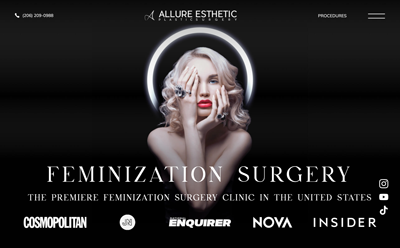Does Your Insurance Plan Cover Gender-Affirming Hairline Feminization or Masculinization?
If you’re thinking about hairline feminization or masculinization as part of your transition, you’re probably asking the same question so many of us ask about every step of gender‑affirming care: “Will my insurance actually pay for this?”
Hairline changes are deeply personal. Shifting a high, traditionally masculine hairline into a softer, lower position can make your face feel more in sync with your gender. Reshaping or advancing a hairline in a more masculine direction can do the same for you if you are pursuing masculinization. Even though these changes are about how you feel in your body, many insurance plans still look at facial procedures as cosmetic, which makes the insurance piece confusing and stressful.
At Allure Esthetic, we bill most major insurances and spend a lot of time helping you navigate exactly this kind of question. In this blog, we’ll walk through how insurance tends to treat gender‑affirming facial procedures, where hairline feminization or masculinization fits into that picture, and what you can do to give yourself the best chance of coverage.
Where Hairline Feminization or Masculinization Fits in Gender‑Affirming Surgery?
Hairline feminization or masculinization usually lives in the same category as other facial gender‑affirming surgeries. Instead of changing your chest or body, these procedures reshape the frame around your face so that your hairline matches your gender identity and the way you want the world to see you.
Insurers rarely list hairline feminization or hairline masculinization by name in plan documents. Instead, hairline work often sits under broader facial feminization surgery (FFS) or under secondary procedures that support your overall transition. We call out facial feminization, rhinoplasty, tracheal shave, and similar procedures as examples of gender‑affirming surgeries that many plans still label as cosmetic. Hairline work is usually treated the same way behind the scenes.
So when you ask whether your plan covers gender‑affirming hairline surgery, what you’re really asking is how your insurance company treats facial gender‑affirming procedures as a whole.
How Insurance Plans Typically View Gender‑Affirming Facial Procedures
For decades, insurance plans treated almost every gender‑affirming surgery as purely cosmetic and refused coverage. That included facial feminization, chest surgery, and many other procedures. Coverage has slowly started to expand, but that expansion is uneven and not guaranteed.
Here’s what we see around facial coverage:
- Some insurance companies do cover facial feminization.
- Out of common gender‑affirming surgeries in the US, facial feminization is still less likely to be covered than others.
- Many insurance companies write policies that only cover procedures tied to gender identifying characteristics. Because of this, some plans completely exclude facial feminization.
- A plan may approve certain individual facial procedures, like rhinoplasty or a lip lift, for gender affirmation, but deny coverage for other parts of FFS in the same surgical plan.
Even when a plan covers top surgery, the same plan may classify facial feminization, rhinoplasty, tracheal shave, and other gender‑affirming facial procedures as purely cosmetic and exclude them. Hairline feminization or masculinization sits squarely inside this facial category. If a plan is strict with facial gender‑affirming procedures, hairline surgery will usually be affected by the same rules.
Does Your Plan Cover Gender‑Affirming Hairline Surgery?
The honest answer is: it depends on the exact plan, state, and wording of your policy.
About FFS and transgender coverage:
- Some insurance companies cover facial feminization, which may include hairline‑related work when it is part of a comprehensive facial plan.
- Facial procedures are still more likely to be questioned or excluded compared to surgeries like top surgery or gender‑affirming breast augmentation.
- Insurance companies and individual plans differ dramatically, and each state sets its own environment for gender‑affirming care.
In Washington State, we highlight a key protection: insurance companies cannot deny or limit gender‑affirming procedures when those procedures are medically necessary. That rule applies broadly to gender‑affirming surgeries, and plans often look for documentation like:
- A note from a mental health professional.
- A diagnosis of gender dysphoria.
- Evidence that you meet WPATH guidelines.
- Records of hormone therapy or other gender‑affirming care, when relevant.
If you want your plan to treat hairline feminization or masculinization as medically necessary, you usually have to fit that procedure into this same framework.
Outside of Washington, some states do not have laws that prohibit insurance companies from discriminating against gender‑affirming care by denying coverage. In those states, coverage for facial procedures, including hairline work, can be more limited and unpredictable.
Step One: Look for Hidden Exclusions in Your Policy
Before you even call your insurance company, it helps to comb through your policy documents. We specifically suggest looking for hidden transgender exclusions, even in plans that look trans‑friendly on the surface.
In the fine print, a plan might quietly say that it will not cover:
- Services related to sex change
- Sex affirmation surgery
- Gender change
- Transsexualism
- Transition‑related care
- Gender identity disorder
- Gender identity dysphoria
Sometimes a plan even uses broad language like, “All procedures related to being transgender are not covered”. If your policy includes wording like that, facial and hairline surgery are very likely to be excluded unless you switch to a different plan.
On the other hand, if your plan clearly lists gender‑affirming procedures or FFS as covered when medically necessary, you have a stronger starting point for asking about hairline feminization or masculinization.
Step Two: Check Employer Plans and Marketplace Options
If you get health insurance through your workplace, we recommend reviewing all available plans to see whether any of them:
- Cover gender‑affirming procedures, and
- Call out facial feminization or related facial surgeries as covered.
In Washington, many larger carriers have at least some coverage for gender‑related surgeries, although the exact details vary. If you do not have a plan that works through your employer, or if your employer’s plans all exclude gender‑affirming care, the Health Insurance Marketplace can be a resource for finding a more affirming option.
When you apply for Marketplace coverage, we suggest that you:
- Use the full name that appears on your Social Security card, even if it is not your preferred name, so the Social Security Administration records match and do not delay your application.
- Select the sex that appears on your current legal documents until your transition is officially recognized on those records.
You can update your name and sex on your coverage after your legal documents change. When you compare Marketplace plans, it helps to search for any mention of:
- Gender‑affirming surgery
- Facial feminization
- Transgender care
- Exclusion language like the phrases listed above
That way, you know whether hairline feminization or masculinization even has a chance of being considered.
Step Three: Call Your Insurance Company with a Plan
Once you understand your policy’s written rules, you can move to a call. We lay out a simple sequence that you can adapt to hairline surgery:
1. Confirm coverage
Ask directly if your plan covers facial feminization surgery or other gender‑affirming facial procedures. If you already know you want hairline feminization or masculinization, you can describe it as part of facial gender‑affirming surgery and ask whether that kind of procedure is covered.
2. Ask about out‑of‑pocket costs
If facial procedures are covered, ask what your deductible, coinsurance, and any prior authorization requirements look like for surgical services.
3. Confirm that your surgeon can bill your plan
Make sure your surgeon can bill in‑network or out‑of‑network, depending on your plan.
During this call, you can also ask what specific documentation your plan expects for gender‑affirming facial surgery. That leads into the next step.
Step Four: Gather the Documentation Insurance Plans Usually Want
To approve FFS and other gender‑affirming surgeries, insurance companies often expect you to show that the procedure is medically necessary as part of treating gender dysphoria. Here are the common requirements that may apply when you seek coverage for facial procedures:
- A letter of support from a mental health professional.
- A diagnosis of gender dysphoria.
- Confirmation that you meet WPATH guidelines.
- Medical clearances.
- A letter of agreement between your surgeon’s office and your insurance.
- Documentation of hormone therapy or other gender‑affirming care.
- Evidence that you have been living in your affirmed gender for at least a year.
- Proof that other mental and medical conditions are well‑treated.
Insurance companies may also look at prescriptions for hormone replacement therapy and similar history when deciding whether to cover gender‑affirming surgery.
When you want coverage for hairline feminization or masculinization, you can work with your mental health provider to show how your hairline affects your dysphoria, your day‑to‑day comfort, and your ability to move through the world safely and authentically. The stronger the connection to gender dysphoria and overall transition care, the more your request aligns with the way plans already evaluate top surgery, breast augmentation, and FFS.
What If Your Plan Still Says No?
Even when your plan covers some gender‑affirming procedures, it may refuse parts of your surgical plan. Here are a few examples:
- A plan might cover top surgery but not cover nipple grafts.
- A plan may cover some components of FFS but exclude others, depending on how those procedures are listed in policy language.
If your plan agrees to cover parts of facial surgery but denies coverage for hairline feminization or masculinization, you still have options:
- You can proceed with the covered procedures and choose to finance or self‑pay the rest. At Allure Esthetic, we work with financing companies such as CareCredit so you do not have to pay the full amount up front.
- You can adjust your surgical plan so that it fits the procedures your plan is willing to support.
- You can appeal the denial or explore different insurance options in future enrollment periods using employer plans or the Marketplace.
You do not have to navigate that alone.
How We Support You Through the Insurance Process
At Allure Esthetic, we know that insurance feels exhausting, especially when the procedure touches something as visible and emotional as your face or hairline. That’s why we:
- Bill most major insurances.
- Accept all major insurance carriers for gender‑affirming top surgery and work with many plans for other procedures.
- Work with certain out‑of‑state and Medicaid plans when possible.
We also have a full‑time insurance advocate and dedicated insurance coordinators whose job is to:
- Explain your policy in plain language.
- Review how your plan handles gender‑affirming procedures.
- Help you understand the treatment and billing process.
- Communicate directly with your insurance company.
- Guide you through authorizations, required letters, and documentation.
You can lean on that team whether you are pursuing facial feminization, top surgery, gender‑affirming breast augmentation, or exploring hairline feminization or masculinization as part of your overall care plan.
If you feel ready to explore whether your insurance plan could cover gender‑affirming hairline feminization or masculinization as part of facial surgery, you can contact our insurance team directly by phone (206) 209-0988 or visit our website. Our team will look into your specific plan, goals, documentation and map out a path that honors both your identity and your financial reality.
 FeminizationSurgeries.com
FeminizationSurgeries.com
